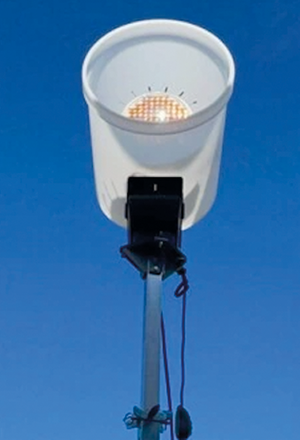

In its pursuit of new technology to improve the deployment of radio access network (RAN) sites, Ericsson has teamed up with US laser innovator, PowerLight Technologies, to achieve the first safe, fully wireless-powered 5G base station. The achievement is part of a partnership between the two companies to explore and develop innovative 5G solutions aimed at enhancing the speed and flexibility of network deployment in diverse environments.
The proof-of-concept (PoC) demo milestone was achieved recently in Seattle using optical beaming – a laser-based technology that converts electricity into high-intensity light which is then captured and transformed into electricity at the radio base station. No wires were connected to the site from the street power grid network and no on-site power generation was involved. The base station site was completely ‘powerless’ until wirelessly powered over the air through a laser beam.
Wireless power was safely distributed to an Ericsson Streetmacro 6701 – a 5G millimetre-wave (mmWave) radio base station. It was achieved using PowerLight’s laser technology to transmit hundreds of watts across hundreds of metres through the air. Ericsson and PowerLight view the milestone as a major step toward an ambitious goal for subsequent generations of the solution to transmit kilowatts of energy over longer distances.
Kevin Zvokel, head of networks for Ericsson North America, said: “Both PowerLight and Ericsson are focused on innovation. This opens new possibilities for Ericsson and its customers. The ability to safely transfer power across distances without having to be connected to the power grid eliminates one of the big obstacles it has when building new cell sites. The time savings and flexibility gains will make this an attractive solution for its customers.”
Expanding on the breakthrough and the potential it entails, the executive chairman of PowerLight Technologies, Claes Olsson, stated that “Most people are aware that wireless charging technology is available today for small electronic devices, such as cellphones and watches. This breakthrough demonstration, which utilised the best innovative technology from PowerLight and Ericsson, underscores the major leaps it has made recently toward the commercialisation of safe, wireless power transmission for larger-scale systems. PowerLight is developing systems today to transfer kilowatts of safe power over distances of kilometres that will be commercially available in the next few years.”
The demonstration also underlined the safety of the technology: the laser beam has a virtual shield or safety ring that automatically and temporarily shuts down power transmission before any living or inanimate object crosses its path. When the safety ring is activated, the site’s backup battery takes over until the beam is cleared. Vital base stations use batteries for local energy provisioning to ensure highly reliable mobile services.
With wireless power, Ericsson is aiming to cut the last cable – the power cord. This next-generation technology demo shows how power can be distributed wirelessly and create new and innovative network deployment and use-case opportunities.
Apart from rapid street radio rollouts, wireless power could support use cases such as provisional deployments in case of emergency or time-specific densification demands, for example during music festivals and sport events. It could also support power-cable-free machines such as automated guided vehicles and drones, as well as devices like IoT sensors and lamps. Communications service providers would also have the flexibility to position a base station without compromising communication needs in relation to where a power wire is located.
The two companies are exploring the possibility of delivering safe wireless power-beaming capabilities to enable cleaner and more sustainable operations for mobile networks.

© Technews Publishing (Pty) Ltd | All Rights Reserved